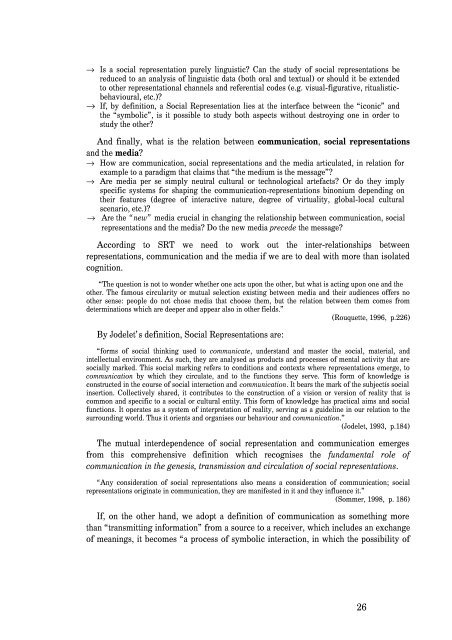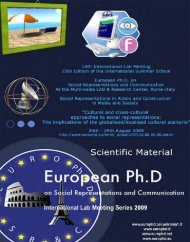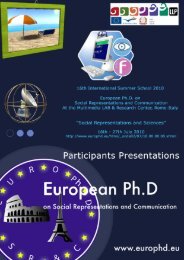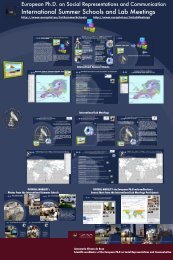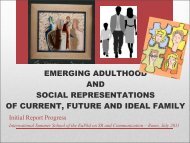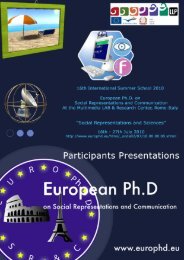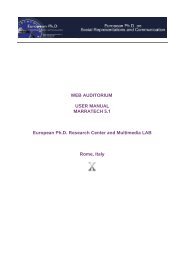The "boomerang" effect of the radicalism in discourse analysis
The "boomerang" effect of the radicalism in discourse analysis
The "boomerang" effect of the radicalism in discourse analysis
Create successful ePaper yourself
Turn your PDF publications into a flip-book with our unique Google optimized e-Paper software.
→ Is a social representation purely l<strong>in</strong>guistic? Can <strong>the</strong> study <strong>of</strong> social representations be<br />
reduced to an <strong>analysis</strong> <strong>of</strong> l<strong>in</strong>guistic data (both oral and textual) or should it be extended<br />
to o<strong>the</strong>r representational channels and referential codes (e.g. visual-figurative, ritualisticbehavioural,<br />
etc.)?<br />
→ If, by def<strong>in</strong>ition, a Social Representation lies at <strong>the</strong> <strong>in</strong>terface between <strong>the</strong> “iconic” and<br />
<strong>the</strong> “symbolic”, is it possible to study both aspects without destroy<strong>in</strong>g one <strong>in</strong> order to<br />
study <strong>the</strong> o<strong>the</strong>r?<br />
And f<strong>in</strong>ally, what is <strong>the</strong> relation between communication, social representations<br />
and <strong>the</strong> media?<br />
→ How are communication, social representations and <strong>the</strong> media articulated, <strong>in</strong> relation for<br />
example to a paradigm that claims that “<strong>the</strong> medium is <strong>the</strong> message”?<br />
→ Are media per se simply neutral cultural or technological artefacts? Or do <strong>the</strong>y imply<br />
specific systems for shap<strong>in</strong>g <strong>the</strong> communication-representations b<strong>in</strong>onium depend<strong>in</strong>g on<br />
<strong>the</strong>ir features (degree <strong>of</strong> <strong>in</strong>teractive nature, degree <strong>of</strong> virtuality, global-local cultural<br />
scenario, etc.)?<br />
→ Are <strong>the</strong> “new” media crucial <strong>in</strong> chang<strong>in</strong>g <strong>the</strong> relationship between communication, social<br />
representations and <strong>the</strong> media? Do <strong>the</strong> new media precede <strong>the</strong> message?<br />
Accord<strong>in</strong>g to SRT we need to work out <strong>the</strong> <strong>in</strong>ter-relationships between<br />
representations, communication and <strong>the</strong> media if we are to deal with more than isolated<br />
cognition.<br />
“<strong>The</strong> question is not to wonder whe<strong>the</strong>r one acts upon <strong>the</strong> o<strong>the</strong>r, but what is act<strong>in</strong>g upon one and <strong>the</strong><br />
o<strong>the</strong>r. <strong>The</strong> famous circularity or mutual selection exist<strong>in</strong>g between media and <strong>the</strong>ir audiences <strong>of</strong>fers no<br />
o<strong>the</strong>r sense: people do not chose media that choose <strong>the</strong>m, but <strong>the</strong> relation between <strong>the</strong>m comes from<br />
determ<strong>in</strong>ations which are deeper and appear also <strong>in</strong> o<strong>the</strong>r fields.”<br />
(Rouquette, 1996, p.226)<br />
By Jodelet’s def<strong>in</strong>ition, Social Representations are:<br />
“forms <strong>of</strong> social th<strong>in</strong>k<strong>in</strong>g used to communicate, understand and master <strong>the</strong> social, material, and<br />
<strong>in</strong>tellectual environment. As such, <strong>the</strong>y are analysed as products and processes <strong>of</strong> mental activity that are<br />
socially marked. This social mark<strong>in</strong>g refers to conditions and contexts where representations emerge, to<br />
communication by which <strong>the</strong>y circulate, and to <strong>the</strong> functions <strong>the</strong>y serve. This form <strong>of</strong> knowledge is<br />
constructed <strong>in</strong> <strong>the</strong> course <strong>of</strong> social <strong>in</strong>teraction and communication. It bears <strong>the</strong> mark <strong>of</strong> <strong>the</strong> subjectís social<br />
<strong>in</strong>sertion. Collectively shared, it contributes to <strong>the</strong> construction <strong>of</strong> a vision or version <strong>of</strong> reality that is<br />
common and specific to a social or cultural entity. This form <strong>of</strong> knowledge has practical aims and social<br />
functions. It operates as a system <strong>of</strong> <strong>in</strong>terpretation <strong>of</strong> reality, serv<strong>in</strong>g as a guidel<strong>in</strong>e <strong>in</strong> our relation to <strong>the</strong><br />
surround<strong>in</strong>g world. Thus it orients and organises our behaviour and communication.”<br />
(Jodelet, 1993, p.184)<br />
<strong>The</strong> mutual <strong>in</strong>terdependence <strong>of</strong> social representation and communication emerges<br />
from this comprehensive def<strong>in</strong>ition which recognises <strong>the</strong> fundamental role <strong>of</strong><br />
communication <strong>in</strong> <strong>the</strong> genesis, transmission and circulation <strong>of</strong> social representations.<br />
“Any consideration <strong>of</strong> social representations also means a consideration <strong>of</strong> communication; social<br />
representations orig<strong>in</strong>ate <strong>in</strong> communication, <strong>the</strong>y are manifested <strong>in</strong> it and <strong>the</strong>y <strong>in</strong>fluence it.”<br />
(Sommer, 1998, p. 186)<br />
If, on <strong>the</strong> o<strong>the</strong>r hand, we adopt a def<strong>in</strong>ition <strong>of</strong> communication as someth<strong>in</strong>g more<br />
than “transmitt<strong>in</strong>g <strong>in</strong>formation” from a source to a receiver, which <strong>in</strong>cludes an exchange<br />
<strong>of</strong> mean<strong>in</strong>gs, it becomes “a process <strong>of</strong> symbolic <strong>in</strong>teraction, <strong>in</strong> which <strong>the</strong> possibility <strong>of</strong><br />
26


